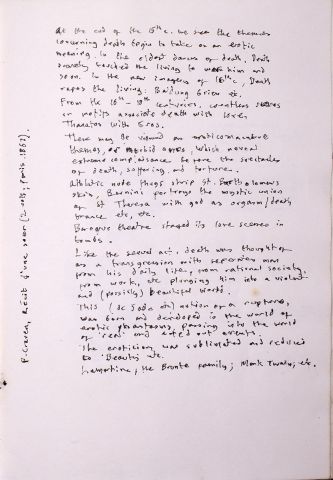At the end of the 15th C we see the themes concerning death begin to take on an erotic meaning. In the oldest dance of death, Death scarcely touched the living to warn him and so on. In the new imagery of the 16th C, Death raped the living: Baldung Grien etc. From the 16th – 18th centuries, countless scenes or motifs in art or literature associate death with love, Thanatos with Eros. These may be viewed as erotico-macabre themes, or morbid ones, which reveal extreme complaisance before the spectacles of death, suffering, and torture. Athletic nude thugs strip St Bartholomew’s skin. Bernini portrays the mystic union of St Theresa with God as orgasm/death trance etc, etc. The baroque theatre staged its love scenes in tombs [such as that of the Capulets].
Like the sexual act, death was thought of as a transgression which separates man from his daily life, from rational society, from work, etc, plunging him into a violent and possibly beautiful world. This (de Sade etc) idea of a rupture was born and developed in the world of erotic phantasms, passing into the world of ‘real’ and acted-out events. The eroticism was sublimated and reduced to ‘Beauty’ etc. Lamartine; the Bronte family; Mark Twain etc.
Pauline Craven, Recit d’une soeur (2 vols; Paris. 1867).









